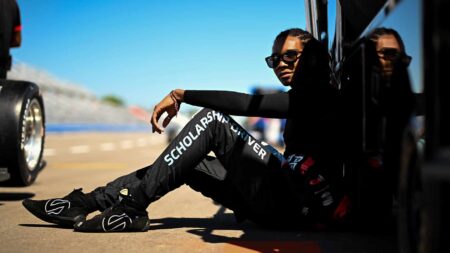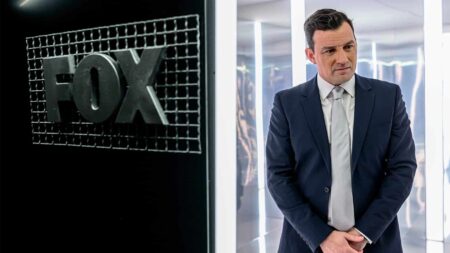
Lundgaard: McLaren can make history with F1/IndyCar double win
Christian Lundgaard is McLaren's new IndyCar star – and wants to make history by helping the team win both in F1 at Bahrain and at Long Beach Stateside on the same day
Main image: IMS
Roger Penske’s four Dallara-Chevrolets – driven by three-time Indy 500 winner Hélio Castroneves, 2000 winner Juan Pablo Montoya, defending IndyCar champion Will Power and team newcomer Simon Pagenaud – have been the cars to beat in the opening races of the IndyCar season and are among the favourites to win this year’s 99th Indy 500. Team Penske is shooting for its 16th win in the big race, the last coming with Castroneves in 2009 and the first 43 years ago with Mark Donohue.
Penske’s IndyCar team is the most successful in the history of American open-wheel racing, of course, with 15 Indy 500 victories, 176 USAC/CART/IRL/IndyCar wins, 229 poles and 13 championships. In all, Roger’s race teams have won 27 American racing championships.

Today, Penske’s NASCAR and IndyCar teams are run out of a giant operation sprawling across 105 acres and employing 500 people in Mooresville, North Carolina. But when Roger started his race team back in 1966, it occupied a tiny, single-car garage in Newtown Square, Pennsylvania, and there was but one employee, Karl Kainhofer. A few weeks later Penske hired Mark Donohue to drive his cars and lead the fledgling little team.
Donohue, Penske and Kainhofer won the United States Road Racing Championship in 1967 and repeated as USRRC champion in ‘68. Donohue also won the Trans-Am title for the first time in that year and finished third in the Can-Am behind the factory McLarens of Bruce and Denny Hulme. Penske also made his first move into Indy cars in ‘68 when Donohue raced an Eagle-Chevy in a pair of USAC road races at Mosport and Riverside.
“In those days we raced two or three different types of cars,” Kainhofer recalls. “It seemed like we were doing something different every day. In ‘68, there were just six or seven guys working on the Camaro Trans-Am cars, the McLaren Can-Am car and the Eagle Indycar.”
Donohue won the Trans-Am championship yet again in ‘69 and also made his and Penske’s rookie start at Indianapolis. Aboard a turbo Offy-powered Lola T152 Donohue qualified fourth and was battling Dan Gurney for second in the race when the magneto failed. After a pitstop for repairs Donohue finished seventh, taking the 500’s ‘rookie of the year’ honours.

Photo: IMS
In 1970 Penske’s primary effort went into running a pair of AMC Javelins in the Trans-Am series for Donohue and Peter Revson. At Indianapolis Donohue raced a Lola-turbo Ford, finishing second to Al Unser with Dan Gurney third. Donohue ran three other USAC races that year and also raced a Lola-Chevy in three SCCA Formula 5000 races, winning at Mosport and Sebring.
In ‘71 Donohue’s plate was extremely full. He won Penske’s third Trans-Am championship; co-drove Penske’s Ferrari 512M with David Hobbs at Daytona, Sebring, Le Mans and Watkins Glen; ran the Canadian and United States GPs in a Penske-prepared McLaren M19, finishing third in his F1 debut at Mosport; raced an F5000 Lola in the Questor Grand Prix in California; and ran nine USAC Championship races, Indy 500 included.
Penske and Donohue had switched to McLaren’s new wedge-shaped M16 Indycar and scored the team’s first Indycar win in the Pocono 500 in July and also won a 200-mile race at Michigan two weeks later.
Comments Penske: “Through our long-standing relationship with Bruce [McLaren], Teddy Mayer and Tyler Alexander, Mark and I were impressed with their new design incorporating aerodynamic advances, which we decided was what we needed to be competitive, especially at Indianapolis.
“They were also interested in having Mark work with them on development of the cars. While we had the benefit of the McLaren design, we also had Mark and Karl Kainhofer heading up the program. Through Mark’s testing and development of the McLaren cars and Karl’s immaculate preparation, we had a really competitive package.”

Photo: IMS
But at Indianapolis, Donohue was out of luck after setting the pace through practice and leading the race’s opening 50 laps. “In ‘71 with the McLaren we were the fastest car all month long, except that Peter Revson beat us on qualifying day,” Kainhofer recalls. “In those days you could play so much with the Offy. You could crank boost in and out and we could run 1100 horsepower for qualifying. It was somewhere around 850-900 for the race. In qualifying Mark had a little bit too much oversteer, so just before he went out to qualify he had me take some boost out and we lost the pole to Revson. They cranked a little more boost in and got us by a little bit.”
Still, Donohue was the man to beat on race day. “We led most of the first 66 laps and then the top gear broke,” Kainhofer says. “That was one of the things that was out of our hands in those days. They had new gears made because there was a problem but they used the wrong material. They found that out later.
“That was a beautiful car,” Kainhofer adds. “I think that was one of the nicest cars ever. After that the cars got bulkier and the wings got up in the air and they got kinda chunky looking. But in ‘71 it had that low wing and was a very slim car, just a nice-looking car.”
For 1972 Penske fielded a new NASCAR operation running AMC Matadors and a new Can-Am team devoted to racing Porsche’s mighty Porsche 917/10. For his Indycar team Penske hired Gary Bettenhausen to partner Donohue. Gary was the oldest son of 1951 and ‘58 Indycar champion Tony Bettenhausen and had won the USAC Sprint car championship in 1969 and ‘71.

Bettenhausen made his rookie start at Indianapolis in 1968 and immediately showed what he could do with Penske, winning the second race of the ‘72 USAC season in April at Trenton aboard one of Penske’s new McLaren M16Bs.
That year saw the biggest jump in speed in Indy 500 history thanks to a combination of substantial increases in power and downforce with prodigious amounts of boost screwed into the venerable four-cylinder Offenhauser, plus rapidly evolving, massive wings. The result was that Bobby Unser broke the previous year’s track record by almost 18mph in the factory AAR Eagle followed closely by Peter Revson in the number one factory McLaren and Donohue and Bettenhausen in Penske’s McLarens.
“With the rules package at that time,” Penske observes, “there was opportunity for considerable development happening on all fronts – engines, chassis designs, aerodynamics and tyres. It was very challenging to develop the most competitive package you could, which Mark and I spent a lot of time sorting out. There was a lot of manufacturer and sponsor involvement and it was great racing among great teams and drivers. And I think it built the fan interest in Indycar racing, especially at Indianapolis where we had great crowds all month.”
Unser led the opening laps of the ‘72 500 before dropping out with a broken ignition rotor. Bettenhausen then took over the lead, chased by Donohue and Jerry Grant in AAR’s second Eagle. For most of the distance Bettenhausen appeared to have the race in the bag, leading 138 laps before he was stopped by a magneto problem.

Bobby Unser, 1972. Photo: IMS
Jerry Grant took the lead for a handful of laps but he was struggling physically with a weak neck, then pulled in for a splash of fuel taken illegally from team-mate Unser’s refuelling rig so that USAC didn’t score Grant’s final 12 laps. Meanwhile, Donohue took the lead and drove home to beat Al Unser by more than a lap.
“With his engineering background and racing experience, Mark always took a very analytical approach to setting up the cars,” Penske comments. “He always considered every variable and worked through them when he tested the cars to achieve the most competitive set-up he was comfortable with driving. He loved to test and was one of Goodyear’s favourite test drivers based on the comprehensive feedback he could communicate for their tyre development. His focus was not just on having the fastest car but also the best race set-up over long runs, as his performance record verified.
“At Indy in ’72, Mark drove a steady pace all day adapting the set-up to the track as it changed. Karl and the crew did a great job on our pitstops and when the window of opportunity opened late in the race Mark had the car set up just the way he wanted it and was ready to go.”
Penske had planned to win the Indy 500 by his third attempt but it took one more than Roger anticipated. “Roger had this three-year program,” Kainhofer grins. “We were going to try to win it in three years and we almost did. But we did it in the fourth year.”

Photo: IMS
Penske’s second Indy win didn’t come until 1979 with Rick Mears, followed in rapid order by a skein of 500 victories with Bobby Unser in ‘81, Mears again in ‘84, Danny Sullivan in ‘85, Al Unser in ‘87, Mears again in ‘88 and ‘91, Emerson Fittipaldi in ‘93, Al Unser Jr in ‘94, Hélio Castroneves in ‘01 and ‘02, Gil de Ferran in ‘03, Sam Hornish in ‘06 and Castroneves again in ‘09.
Looking back on his epic career as a team owner and businessman Penske says Donohue set the standard for both sides of his empire. “Mark and I worked closely together on planning all of our programs and we were fortunate to have dedicated, talented people on the team,” Penske remarked. ”We had a small, core group of mechanics and fabricators who handled the preparation of the cars and colleagues who came in on weekends to fill out our pit crews. It was a considerably smaller group than the specialists we have today on the team.
“As chronicled in many articles and books Mark’s dedication to Penske Racing was legendary. He had a ten-tenths commitment to the team and our programs. He set a great work ethic example with our people on the day-to-day operations and what it took to get the job done.
“There was no job too big or too small in his eyes,” Penske added. “After the crew worked several straight days to prepare the Ferrari 512 for Sebring in ‘71 for example, he insisted on driving the transporter from Newtown Square, PA to the track! While we worked together closely on all fronts to achieve our goals, the record book is testament to his contribution.”
Penske Racing’s foundation was built on the shoulders of Mark Donohue and Karl Kainhofer, two genuinely remarkable men from a very different era.

Christian Lundgaard is McLaren's new IndyCar star – and wants to make history by helping the team win both in F1 at Bahrain and at Long Beach Stateside on the same day

Louis Foster starts his IndyCar journey this weekend in St Petersburg – can he emulate other British heroes like Nigel Mansell and Dan Wheldon?

Myles Rowe has rocketed through IndyCar's junior ladder with a story like no other – he tells James Elson why this upcoming year is more important than ever

Drive to Survive star Will Buxton has made the jump across the Atlantic to front Fox's new IndyCar coverage – he explained to James Elson why he thinks the championship is the most exciting series out there